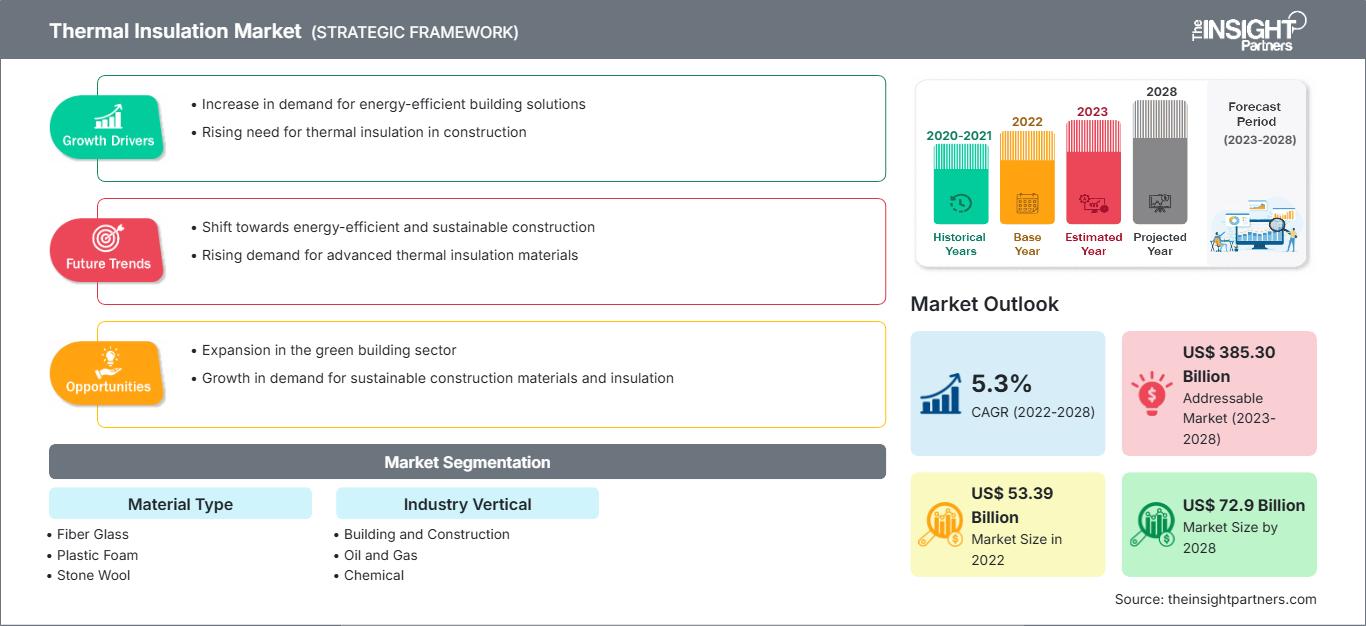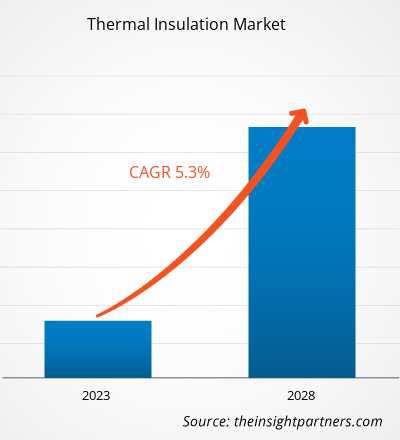Le marché de l'isolation thermique devrait passer de 53,39 milliards de dollars américains en 2022 à 72,90 milliards de dollars américains en 2028 ; sa croissance devrait atteindre un TCAC de 5,3 % entre 2022 et 2028.
La demande d'isolation thermique a augmenté en raison de ses avantages. Elle réduit les coûts énergétiques et le transfert de chaleur entre deux objets de températures différentes. Les matériaux d'isolation thermique offrent une isolation dans laquelle la chaleur radiante est réfléchie, réduite et absorbée. Les entreprises se concentrent sur la fourniture de produits légers comme le plastique, car ils sont faciles à installer et nécessitent moins de temps et d'efforts. Ces facteurs devraient stimuler la croissance du marché de l'isolation thermique.
Le marché de l'isolation thermique devrait connaître une croissance significative dans les années à venir grâce à la forte présence d'acteurs de premier plan, tels que BASF SE, Bayer AG, ROCKWOOL A/S, Johns Manville, SAINT GOBAIN SA, Kingspan Group PLC, Dow Chemicals Company, Owens Corning, Asahi Kasei Corporation et DuPont. Une grande variété de produits d'isolation thermique a retenu l'attention des consommateurs. La sensibilisation croissante aux avantages de l'isolation haute température, notamment la résistance aux températures élevées et aux chocs thermiques, la faible conductivité thermique, les avantages environnementaux et la rentabilité, devrait propulser la croissance du marché de l'isolation thermique au cours de la période de prévision.
En 2021, l'Asie-Pacifique détenait la plus grande part du marché mondial de l'isolation thermique. Cependant, l'Amérique du Nord devrait enregistrer le TCAC le plus élevé du marché au cours de la période de prévision. Le marché APAC est segmenté en Chine, Inde, Australie, Japon, Corée du Sud et reste de l'APAC. Le secteur de la construction est l'un des secteurs en plein essor de la région Asie-Pacifique en raison de la croissance rapide de la population, ce qui entraîne une forte demande en produits d'isolation thermique. De plus, l'augmentation du revenu disponible des consommateurs et la croissance de la classe moyenne sont quelques-uns des principaux facteurs de croissance du marché de l'isolation thermique dans la région.
Vous bénéficierez d’une personnalisation sur n’importe quel rapport - gratuitement - y compris des parties de ce rapport, ou une analyse au niveau du pays, un pack de données Excel, ainsi que de profiter d’offres exceptionnelles et de réductions pour les start-ups et les universités
Marché de l'isolation thermique: Perspectives stratégiques

-
Obtenez les principales tendances clés du marché de ce rapport.Cet échantillon GRATUIT comprendra une analyse de données, allant des tendances du marché aux estimations et prévisions.
Impact de la pandémie de COVID-19 sur le marché de l'isolation thermique
Avant la pandémie de COVID-19, la croissance du marché de l'isolation thermique était principalement tirée par la demande croissante de bâtiments et d'activités de construction. Cependant, le marché a rencontré des obstacles au cours du premier trimestre 2020 en raison de la fermeture des entreprises, des pénuries de matières premières et de main-d'œuvre, et du déclin des activités de construction et de transport. La pandémie de COVID-19 a entraîné une récession économique au cours des premiers mois de 2020, ce qui a créé des difficultés financières pour les consommateurs à faibles et moyens revenus.
De plus, en raison des restrictions, la fermeture de nombreuses entreprises de construction et de fabrication a affecté la croissance du marché de l'isolation thermique. De plus, pendant la pandémie, la pénurie de main-d'œuvre a été une préoccupation majeure pour le secteur de l'isolation thermique. Cela a conduit à une évolution vers la mécanisation, l'automatisation et la fabrication hors site dans le secteur de l'isolation thermique.
Aperçu du marché
Avantages de l'isolation thermique
L'isolation thermique réduit les mouvements de chaleur et la condensation de vapeur. Par conséquent, elle prévient l'humidité, la moisissure, le gel, les déformations qui peuvent survenir dans le bâtiment et l'affaiblissement des pièces en fer dû à la corrosion ; elle contribue à la préservation du bâtiment. De plus, dans divers secteurs, d'importantes économies d'énergie peuvent être réalisées grâce à une conductivité thermique réduite dans la construction du revêtement grâce à l'utilisation de produits tels que l'isolant BTU-BLOCK.
Selon le type de matériau, le marché mondial est classé en fibre de verre, mousse plastique, laine de roche, silicate de calcium, verre cellulaire, etc. En 2021, le segment de la fibre de verre représentait la plus grande part de chiffre d'affaires et la mousse plastique devrait connaître le taux de croissance le plus élevé au cours de la période de prévision. Par secteur d'activité, le marché mondial est segmenté en bâtiments et construction, pétrole et gaz, chimie, aérospatiale et défense, automobile, pharmaceutique, etc. Le secteur du bâtiment et de la construction représente la plus grande part de chiffre d'affaires. BASF SE, Bayer AG, ROCKWOOL A/S, Johns Manville, SAINT GOBAIN SA, Kingspan Group PLC, Dow Chemicals Company, Owens Corning, Asahi Kasei Corporation et DuPont comptent parmi les principaux acteurs du marché de l'isolation thermique. Ces entreprises proposent une large gamme de produits. Implantées dans les régions en développement, elles offrent des débouchés lucratifs. Les acteurs du marché développent des produits innovants et de haute qualité pour répondre aux exigences des clients.
Points forts du rapport
- Tendances progressives du marché pour aider les acteurs à élaborer des stratégies efficaces à long terme
- Stratégies de croissance adoptées par les marchés développés et en développement
- Analyse quantitative de la taille du marché des produits d'isolation thermique de 2022 à 2028
- Estimation de la demande mondiale d'isolation thermique
- Analyse PEST pour illustrer l'efficacité des acheteurs et des fournisseurs opérant dans le secteur
- Évolutions récentes pour comprendre le scénario de marché concurrentiel
- Tendances et perspectives du marché et facteurs qui stimulent et freinent la croissance du marché de l'isolation thermique
- Aide à la prise de décision en mettant en évidence les stratégies de marché qui sous-tendent l'intérêt commercial et conduisent à la croissance du marché
- Taille du marché de l'isolation thermique à différents niveaux
- Aperçu détaillé et segmentation du marché, ainsi que du secteur de l'isolation thermique Dynamique
- Taille du marché de l'isolation thermique dans diverses régions avec des opportunités de croissance prometteuses
Aperçu régional du marché de l'isolation thermique
Les tendances régionales et les facteurs influençant le marché de l'isolation thermique tout au long de la période de prévision ont été analysés en détail par les analystes de The Insight Partners. Cette section aborde également les segments et la géographie du marché de l'isolation thermique en Amérique du Nord, en Europe, en Asie-Pacifique, au Moyen-Orient et en Afrique, ainsi qu'en Amérique du Sud et en Amérique centrale.
Portée du rapport sur le marché de l'isolation thermique
| Attribut de rapport | Détails |
|---|---|
| Taille du marché en 2022 | US$ 53.39 Billion |
| Taille du marché par 2028 | US$ 72.9 Billion |
| TCAC mondial (2022 - 2028) | 5.3% |
| Données historiques | 2020-2021 |
| Période de prévision | 2023-2028 |
| Segments couverts |
By Type de matériau
|
| Régions et pays couverts |
Amérique du Nord
|
| Leaders du marché et profils d'entreprises clés |
|
Densité des acteurs du marché de l'isolation thermique : comprendre son impact sur la dynamique des entreprises
Le marché de l'isolation thermique connaît une croissance rapide, portée par une demande croissante des utilisateurs finaux, due à des facteurs tels que l'évolution des préférences des consommateurs, les avancées technologiques et une meilleure connaissance des avantages du produit. Face à cette demande croissante, les entreprises élargissent leur offre, innovent pour répondre aux besoins des consommateurs et capitalisent sur les nouvelles tendances, ce qui alimente la croissance du marché.

- Obtenez le Marché de l'isolation thermique Aperçu des principaux acteurs clés
- Analyse historique (2 ans), année de base, prévision (7 ans) avec TCAC
- Analyse PEST et SWOT
- Taille du marché Valeur / Volume - Mondial, Régional, Pays
- Industrie et paysage concurrentiel
- Ensemble de données Excel
Rapports récents
Rapports connexes
Témoignages
Raison d'acheter
- Prise de décision éclairée
- Compréhension de la dynamique du marché
- Analyse concurrentielle
- Connaissances clients
- Prévisions de marché
- Atténuation des risques
- Planification stratégique
- Justification des investissements
- Identification des marchés émergents
- Amélioration des stratégies marketing
- Amélioration de l'efficacité opérationnelle
- Alignement sur les tendances réglementaires






















 Obtenez un échantillon gratuit pour - Marché de l'isolation thermique
Obtenez un échantillon gratuit pour - Marché de l'isolation thermique